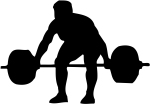Group: Strength & Powerlifting
Created: 2012/01/01,
Members: 39,
Messages: 16459
Discuss the topic of Power lifting, Strength training and Strong Man training!
Join groupDiscuss the topic of Power lifting, Strength training and Strong Man training!
Join group

Relique
Posts:
187
Joined: 2004/03/17  |
2004/04/05, 01:19 PM
I looked around a bit and could not find a good description on squat training. I have never done squats before in a cage, with a bar or anything of that sort, nor with any significant weight. What I have done is dumbell squats with about 30lbs to 50lbs in each hand, I do a bunch of these when I am doing my dumbell exercise (really works the full body well)
Can anyone please post a good way to get into squating? I would assume a few days with an empty bar to get good form, but how far down do I want to go? to a 90? or do I go down further/not as much? Feet shoulder width apart I assume, looking strait forward. Any advice/input would be great! -------------- Sean "TBAR" Johnson -USAF- |
|
| |

mmaibohm
Posts:
1,621
Joined: 2003/09/30  |
2004/04/05, 03:04 PM
This is from an article from Animalpak website by the lad
Movement The biggest and most common mistake occurs when a lifter starts the movement. Usually, I see a lot of guys begin by bending their knees. The first bending motion should be in the hips. You should dip your hips back, like your going to sit into a chair, trying to keep your shins as upright as possible. If you watch someone from the side do a squat correctly, the motion of the bar goes almost straight down and straight up. This method keeps the bar over the central most part of your body, enabling you to use your entire body and not just your legs. Believe me, this makes a world of difference. Bar Placement: Bar placement could be a major factor in the weights you handle depending on the style of squat you’re doing. If the bar is placed to high on the traps, it could cause you to bend too much at the waist. This will throw your hips up at the bottom of the squat, dumping a heavier weight over your head. Placing the bar too low on your back would cause a similar problem. In this case, the bar could roll down your back, placing a great deal of stress on your rotator cuffs. The ideal placement of the bar would be between the lower traps and upper rear delts. Over time, you will create a comfort zone we powerlifters call the “shelf”. You may have to hold your elbows up during the squat to create this shelf. Grip : Another factor dealing with bar placement is your grip on the bar. You want to stay as tight as you possibly can during the squat, so it helps to squeeze the bar in order to maintain a firm grip. This will also help to keep the bar from rolling up and down during the lift. If your wrist or shoulders start to hurt while squatting, you may want to widen your hand placement. Just remember, the wider your hands, the greater the chance that the bar will roll on you. Foot Placement: Foot placement is probably the biggest issue when it comes to squatting. Again, it all depends on the individual lifter. A good rule of thumb to remember is that a lifter with larger hips will tend to squat better with a wider stance and a lifter with larger quads will tend to squat better with a closer stance. When squatting, I personally like to look down at the ground until I’m set with the weight on my back. This way you can actually see your stance, instead of just feeling it. Walkout: Up until a few years ago, the walkout played a big part in the squat. But due to safety reasons, the mono-lift style squat rack was developed. In this style of rack, you have your feet already in place, knees bent, and back straight. As you straighten your legs to stand erect, your spotter lifts a lever that moves the rack out from under you. Now all of your strength can be used to squat. If you do not have access to a mono-lift style squat rack, you can use this same form in a power rack. Just have your spotters pull the safety pins as you stand up with the weight. Breathing: Believe it or not, the way you breathe can play a factor in your squat or for that matter any lift where you strain. You never want to exhale during the decent of a lift, especially the squat. Take a deep breath and hold it as you squat. Some lifters yell, scream or exhale as they come up from the bottom. Me, I personally hold my breath all the way through the lift. -------------- I am that which must be feared, worshipped and adored. The world is mine now and forever.No one holds command over me. No man. No god. I am a beast and that is enough. |

Relique
Posts:
187
Joined: 2004/03/17  |
2004/04/05, 06:11 PM
That is great, it answers a lot of my questions, I have always herd that doing a squat incorrectly could cause serious injury.
He refers to "traps" in that for bar placement, what is that? where exactly do you place the bar, I always thought it was atop the virtabre that finishes your back and then begins your neck? or do you place it on your shoulders more over? -------------- Sean "TBAR" Johnson -USAF- |

jcannuck
Posts:
210
Joined: 2004/01/31  |
2004/04/05, 06:33 PM
Traps are the angular muscles leading from the back of your neck to your shoulders, they kind of from an inverted "V" looking at yourself in the mirror.
|
